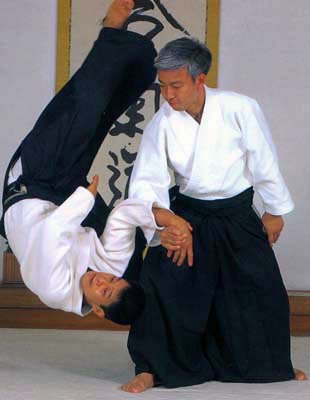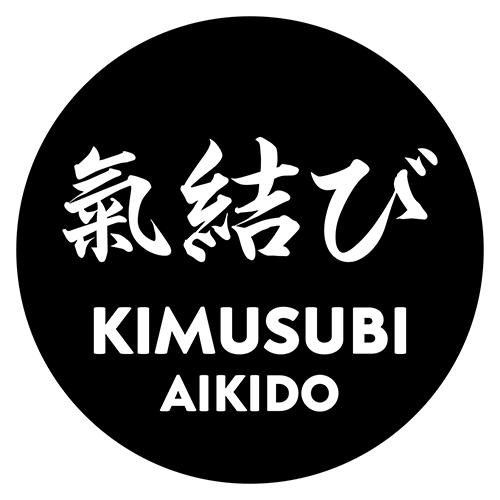What is Aikido?
Aikido 合氣道 is a traditional Japanese martial art created by Morihei Ueshiba O Sensei who, along with Kano Jigoro Sensei (the founder of Judo 柔道) and Funakoshi Gichin Sensei (the founder of Karate-dō 空手道), brought Japanese bujutsu (the traditional Japanese warrior arts) into the 20th century.
These revolutionary teachers taught the warrior principles of the samurai while adding to them a social dimension that emphasized peaceful resolution of conflict and living in harmony with others.
Today these arts are collectively referred to as Budō 武道, or Japanese martial ways, emphasizing their focus on individual self-development, rather than just military application and fighting.
Aikido’s movements appear soft and flowing due to their non-confrontational nature. However, they are at the same time very subtle and powerful. The movements and spirit of Aikido is deeply rooted in the Japanese sword and battlefield arts. They have been synthesized into a complete budo that – while effective for use in self-defense situations – develops awareness, intent, focus, coordinated movement, and physical engagement without the use of strength or resistance. True Aikido technique is executed with a martial “mindset” that has been honed to resemble the Japanese katana (sword).
More importantly for our present day survival, however, the path of Aikido cultivates a similarly honed spirit that is committed to reconciling conflict without responding with reciprocal violence and injury.

“To injure an opponent is to injure yourself. To control aggression without inflicting injury is aikido.”
— Ueshiba Morihei O Sensei
Ultimately, aikido teaches us to replace resistance and control with physical and spiritual connection. In the pursuit of this ideal we discover that self-defense is not found in the defeat or protection from others. Rather, true self-defense is found in freedom from our own internal, physical, and emotional conflicts. Self-defense begins within ourselves.
The Founder of Aikido
Ueshiba Morihei O Sensei
Aikido represents a synthesis of fighting principles that date back over hundreds of years. The art’s present form is the product of a life-long pursuit of the samurai warrior arts by Morihei Ueshiba (1883-1969), referred to by his students as O sensei, or “great teacher”. Ueshiba explored several traditional schools of jujutsu, spear, staff, and sword arts – most notably Daito-ryu Aikijujutsu. From these arts modern-day Aikido was born.
A profoundly spiritual man, O Sensei often lamented the futility of bujutsu, who’s sole purpose was victory and overcoming others. Throughout his life he struggled with this dilemma deeply, and during somewhat of an epiphany, he surmised that winning at the expense of others was—at best—a temporary victory that ultimately lead to one’s own destruction. It was to the essence of this revelation that the Founder would later offer a solution.
Ueshiba termed the phrase, “masakatsu agatsu katsuhayabi”, which translates as “true and correct victory is the victory over oneself.” Transformed by this spiritual insight, O Sensei began to focus on a martial art of refinement and preservation.
In his later years, the Founder maintained that the warrior’s path is a path of love (which subsequently is another translation of the kanji “ai” in Japanese). O sensei believed Aikido was a way to overcome the discord of humanity and a means by which to bring lasting peace to the world.


Aiki Jinja (Aiki Shrine) in Iwama, Japan
The Ueshiba Legacy
Nidai Dōshu - Ueshiba Kisshomaru
Upon the Founder’s death his son, Kisshomaru Ueshiba (1921-1999), assumed the title of Aikido Dōshu, or leader of the way. Many believe that had it not been for the dedication, heroism, and selfless effort of Kisshomaru sensei, the martial art of Aikido would have possibly not survived, much less prospered to the levels seen at present.
This was particularly the case during World War II, when the Allied Forces regularly “carpet-bombed” the major suburbs of Tokyo. On more than one occasion, it was Kisshomaru sensei who kept the fires at bay and preserved the Founder’s Tokyo home and dojo. Kisshomaru Dōshu continued his father’s work up until his passing in 1999, and was largely responsible for the restructuring and organization of Aikido’s technical canon during the late 1960’s and 1970’s.

Sandai Dōshu - Ueshiba Moriteru
Today, O Sensei’s grandson, Moriteru Ueshiba (1951- ), assumes the role of Aikido Dōshu and is both the figurehead of Aikido to the world as well as the General Director of the Aikido World Headquarters in Shinjuku-ku, Japan (a suburb of Tokyo).
From the world headquarters, or Aikikai Hombu Dojo, Moriteru Dōshu oversees the continual spread of Aikido all over the world.
Presently, the art is practiced in over seventy countries.

Waka Sensei - Ueshiba Mitsuteru
From April 2012, Mitsuteru Ueshiba (1980- ) assumed the role of Dojocho of the Aikikai Hombu Dojo, and as such is referred to as Waka-sensei (若先生, “young master”).
This term was applied to Moriteru Ueshiba when the second Dōshu Kisshomaru Ueshiba was still alive, and to Kisshomaru when the founder was still alive. More than simply a title of respect, it is intended to refer to the successor, who will take on leadership after his father.
Waka Sensei is the great-grandson of Morihei Ueshiba.

